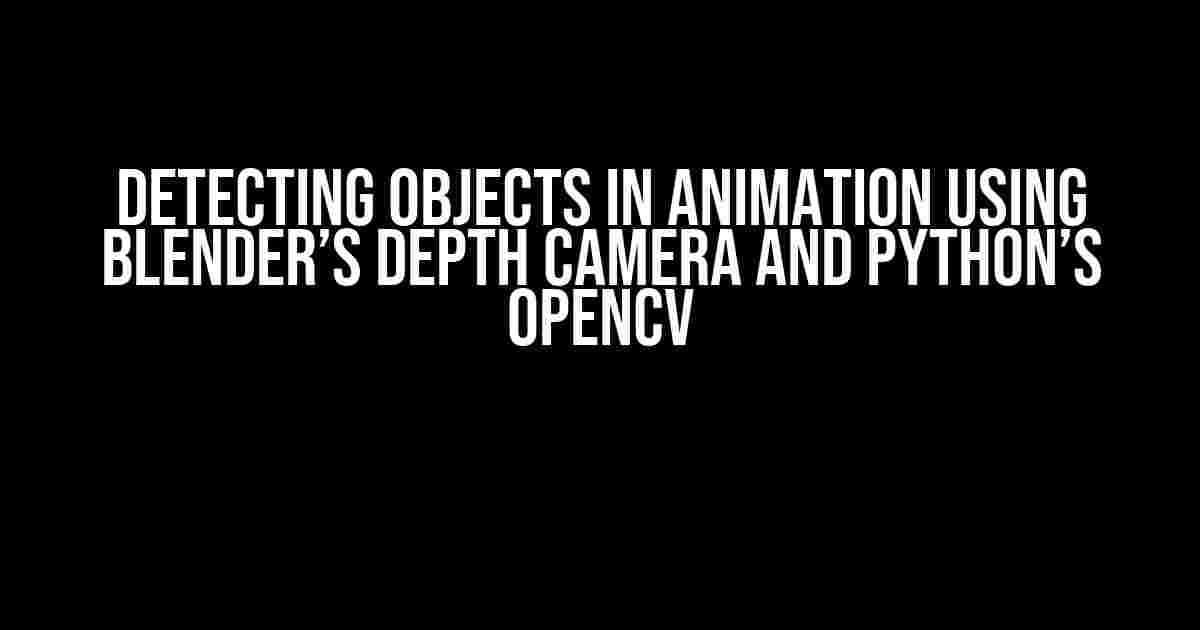Are you an animator looking to add a new level of realism to your animations? Do you want to create interactive 3D models that can detect objects and respond accordingly? Look no further! In this article, we’ll show you how to detect objects in animation using Blender’s depth camera and Python’s OpenCV. Get ready to take your animations to the next level!
What you’ll need
Before we dive into the tutorial, make sure you have the following software and tools installed:
- Blender 2.8 or later: The popular 3D creation software that we’ll be using to create and animate our 3D objects.
- Python 3.6 or later: The programming language that we’ll be using to write our script and interface with OpenCV.
- OpenCV 4.2 or later: The computer vision library that we’ll be using to detect objects in our animation.
- A decent computer with a GPU: Since we’ll be working with 3D models and computer vision, a strong computer with a dedicated GPU is recommended.
Step 1: Setting up Blender’s Depth Camera
In Blender, create a new project and add a cube to the scene. This cube will serve as our 3D object that we want to detect.
Next, add a camera to the scene by clicking on the “Add” menu and selecting “Camera”. In the camera properties, set the camera type to “Depth” and set the resolution to 640×480.
Camera Properties:** * Camera Type: Depth * Resolution: 640x480 * Depth Range: 0.1 - 10.0
The depth camera will output a grayscale image that represents the distance of each pixel from the camera. This information will be used by OpenCV to detect objects in the animation.
Step 2: Writing the Python Script
Create a new Python script in your preferred text editor or IDE. Import the necessary libraries, including OpenCV and the Blender Python API.
import cv2 import bpy
Next, set up the Blender scene and camera using the Python API. We’ll set the camera to render in grayscale mode and set the resolution to match our camera settings in Blender.
We'll also set up a loop to render and capture the image from the camera. This will allow us to capture frames from the animation and process them using OpenCV.
while True: bpy.context.scene.frame_set(bpy.context.scene.frame_current) bpy.context.scene.camera.data.sensor_width = 32 img = bpy.context.scene.render.layers['RenderLayer'].render_result cv2.imshow('Image', img) cv2.waitKey(1)Step 3: Object Detection using OpenCV
In this step, we'll use OpenCV to detect objects in the grayscale image captured from the Blender camera. We'll use the Haar cascade classifier to detect objects, which is a pre-trained model that can detect faces and other objects.
face_cascade = cv2.CascadeClassifier('haarcascade_frontalface_default.xml')We'll then apply the Haar cascade classifier to the captured image using the `detectMultiScale` function.
gray = cv2.cvtColor(img, cv2.COLOR_BGR2GRAY) faces = face_cascade.detectMultiScale(gray, scaleFactor=1.1, minNeighbors=5)The `detectMultiScale` function returns a list of rectangles that represent the detected objects. We can then draw these rectangles on the original image using OpenCV.
for (x, y, w, h) in faces: cv2.rectangle(img, (x, y), (x+w, y+h), (0, 255, 0), 2)Step 4: Integrating with Blender
Now that we have our Python script detecting objects using OpenCV, let's integrate it with Blender. We'll use the Blender Python API to create a custom operator that runs our Python script.
class OBJECTDETECTOR_OT_operator(bpy.types.Operator): bl_idname = "object-detector.operator" bl_label = "Run Object Detector" def execute(self, context): exec(open("object-detector.py").read()) return {'FINISHED'}We'll then register our custom operator in Blender and add a button to the 3D view.
bpy.utils.register_class(OBJECTDETECTOR_OT_operator) bpy.types.VIEW3D_PT_view3d_ctrl.append(OBJECTDETECTOR_OT_operator)Conclusion
And that's it! You've now successfully detected objects in animation using Blender's depth camera and Python's OpenCV. You can use this technique to create interactive 3D models that respond to their environment, or to create realistic simulations that require object detection.
Remember to experiment with different Haar cascade classifiers and object detection algorithms to improve the accuracy of your object detection. Happy animating!
Tips and Variations
Here are some tips and variations to take your object detection to the next level:
- Use different Haar cascade classifiers: OpenCV comes with a range of pre-trained Haar cascade classifiers for detecting different objects, such as eyes, ears, and full bodies.
- Experiment with different object detection algorithms: OpenCV provides a range of object detection algorithms, including YOLO, SSD, and HOG+SVM.
- Use machine learning: Train your own machine learning model using OpenCV and a dataset of images to detect specific objects.
- Integrate with other Blender tools: Use Blender's physics engine to simulate real-world interactions between objects, or use its animation tools to create realistic animations that respond to object detection.
Troubleshooting
Here are some common issues you may encounter and how to troubleshoot them:
Issue Solution OpenCV not installed Install OpenCV using pip: `pip install opencv-python` Blender Python API not working Make sure you have Blender 2.8 or later installed, and that you've imported the Blender Python API correctly: `import bpy` Object detection not working Check that your Haar cascade classifier is correctly configured, and that your object detection algorithm is correctly implemented. I hope this article has been helpful in showing you how to detect objects in animation using Blender's depth camera and Python's OpenCV. Happy animating!
Here is the FAQ section about detecting objects in animation using Blender's depth camera and Python's OpenCV:
Frequently Asked Questions
Got questions about detecting objects in animation using Blender's depth camera and Python's OpenCV? We've got answers!
What is the basic principle behind Blender's depth camera?
Blender's depth camera uses ray-casting to simulate how a real-world camera would perceive depth. It casts virtual rays from the camera into the 3D scene, measuring the distance to the objects in the scene. This allows us to generate a depth map, which is a 2D representation of the 3D scene, where each pixel value represents the distance from the camera to the object in the scene.
How does OpenCV come into play in object detection?
OpenCV is a computer vision library that provides a range of functionalities for image and video processing. In object detection, OpenCV is used to process the depth map generated by Blender's depth camera. We can apply OpenCV's algorithms, such as thresholding, edge detection, and contour finding, to identify and isolate objects within the scene.
What kind of objects can be detected using this method?
This method can be used to detect objects of varying complexity, from simple shapes like cubes and spheres to more complex objects like characters and vehicles. The accuracy of object detection depends on the quality of the depth map and the algorithms used to process it. With advanced algorithms and precise depth maps, it's possible to detect even subtle details like facial expressions or hand gestures.
Can this method be used for real-time object detection in animations?
Yes, with some optimization and tweaking, this method can be used for real-time object detection in animations. By leveraging the power of modern GPUs and optimizing the OpenCV algorithms, it's possible to achieve fast and accurate object detection in real-time. This can be particularly useful in applications like video games, simulations, and virtual reality experiences.
What are some potential applications of this object detection method?
The applications are vast! With accurate object detection in animations, you can create more realistic simulations, enhance video game experiences, or even develop interactive storytelling tools. It can also be used in fields like architecture, product design, and medical visualization to create more immersive and interactive presentations.


